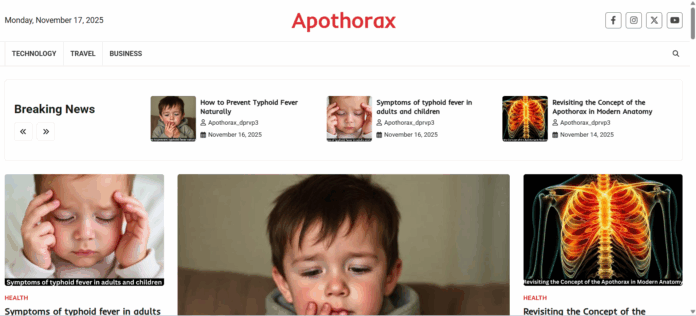The apothorax region is a fascinating yet often overlooked area of human anatomy. While not as commonly referenced as the thorax or abdomen, it provides a critical supporting role for movement, posture, and protection of internal structures. Think of it as the body’s architectural transition zone—strong enough to support major mechanical forces yet flexible enough to enable healthy mobility.
Understanding Its Role in Human Anatomy
The apothorax region serves as a structural and functional link between upper-body components. It houses essential bones, muscles, and connective tissues that work together to maintain stability and facilitate motion.
Why the Apothorax Region Matters
Whether you’re moving your arms, stabilizing your core, or maintaining posture, this region is quietly at work. Injury or dysfunction can significantly impact daily life, making understanding it crucial for clinicians, therapists, and anyone who values full-body health.
Anatomy of the Apothorax Region
Bones Involved
The apothorax region consists of interconnected skeletal structures that act as a rigid yet adaptable framework. These bones support upper-body mechanics while shielding delicate organs from damage.
Muscular Structures
A network of muscles overlays the bones, providing strength, flexibility, and movement. These muscles coordinate with adjacent regions to support breathing, lifting, rotating, and stabilizing the spine.
Connective Tissues & Ligaments
Ligaments and connective fibers bind everything together like sturdy ropes and elastic bands. They prevent excessive movement while allowing necessary flexibility and shock absorption.
Nerve Supply
Nerves passing through the apothorax region relay signals that control movement and sensation. Any disruption—compression, inflammation, or injury—can lead to pain, numbness, or dysfunction.
Blood Supply
A rich network of vessels delivers oxygen and nutrients, supporting tissue health and aiding in rapid recovery from strain or injury.
Structural Functions of the Apothorax
Framework & Protection
The apothorax acts much like the foundation of a building—distributing structural loads and protecting vital internal structures from mechanical forces.
Support for Respiration
Breathing isn’t just about the lungs. The apothorax supports respiratory motions, helping maintain the integrity and flexibility of related muscles and tissues.
Stability for Upper Body Movements
Movements like lifting, pushing, or twisting engage the apothorax. Its structural design helps maintain balance while reducing the risk of injury.
Biomechanics of the Apothorax Region
Movement Patterns
The region allows controlled movement while limiting excessive strain. Its biomechanics blend stability and flexibility, making everyday actions feel natural and supported.
Interaction With Nearby Anatomical Structures
It collaborates closely with the thorax, spine, and shoulder girdle. This interconnectedness helps distribute mechanical loads efficiently.
Load-Bearing Capabilities
The apothorax absorbs and disperses pressure from physical activities, protecting both bones and soft tissues from excessive stress.
Clinical Significance
Common Injuries
Because it is involved in many movements, the apothorax is vulnerable to certain injuries.
Fractures
High-impact trauma or stress can lead to fractures, causing pain, swelling, and reduced mobility.
Strains & Sprains
Sudden or repetitive motions may overstretch the soft tissues, leading to inflammation and discomfort.
Nerve Compression
Misalignment or tissue swelling can compress nerves, resulting in tingling, weakness, or chronic pain.
Postural Disorders
Poor posture places unnecessary strain on the apothorax. Over time, this can lead to misalignment, muscle imbalance, or long-term pain.
Degenerative Conditions
Aging, overuse, or arthritis can weaken the structures of the apothorax, affecting mobility and overall function.
Diagnosis of Apothorax Disorders
Physical Examination
Clinicians assess movement, pain response, and structural integrity to identify potential issues.
Imaging Techniques
X-rays, CT scans, or MRIs help visualize internal components and detect abnormalities.
Differential Diagnosis
Because symptoms can mimic other conditions, accurate diagnosis ensures effective treatment.
Treatment & Management
Conservative Therapies
Rest & Immobilization
Reducing activity allows injured tissues to heal naturally.
Physical Therapy
Targeted exercises restore strength, flexibility, and proper alignment.
Medication
Anti-inflammatory or pain-relieving medications help manage symptoms during recovery.
Surgical Options
If conservative measures fail, surgery may be needed to repair severe structural damage.
Long-Term Rehabilitation
Rehabilitative programs prevent recurrence and support full functional recovery.
Preventive Strategies
Exercise & Strengthening
Regular strengthening of surrounding muscles protects the apothorax from overload and injury.
Postural Awareness
Simple daily adjustments can drastically reduce strain on the region.
Ergonomic Adjustments
Modifying work or home environments can support healthier biomechanics.
Summary of the Apothorax Region’s Importance
The apothorax region may not always get the spotlight, but it’s essential for stability, mobility, and overall body function. Its bones, muscles, and tissues work in harmony to support breathing, posture, and movement.
Conclusion
The apothorax region plays a vital role in structural support, biomechanics, and clinical health. Understanding its anatomy and functions not only helps prevent injury but enhances appreciation of the body’s remarkable design. Whether you’re a clinician, student, or simply curious, gaining insight into this region can provide valuable perspectives on human movement and wellness.
FAQs
1. What is the apothorax region?
It’s a supportive anatomical zone involved in movement, posture, and respiratory mechanics.
2. Why is the apothorax clinically important?
Injuries or disorders here can affect mobility, nerve function, and daily activities.
3. How can apothorax injuries be prevented?
Regular exercise, proper posture, and ergonomic adjustments help reduce risk.
4. What symptoms indicate dysfunction in the apothorax region?
Pain, restricted movement, numbness, or muscle weakness are common signs.
5. Can apothorax disorders heal without surgery?
Many cases respond well to conservative treatments such as physical therapy and rest.
